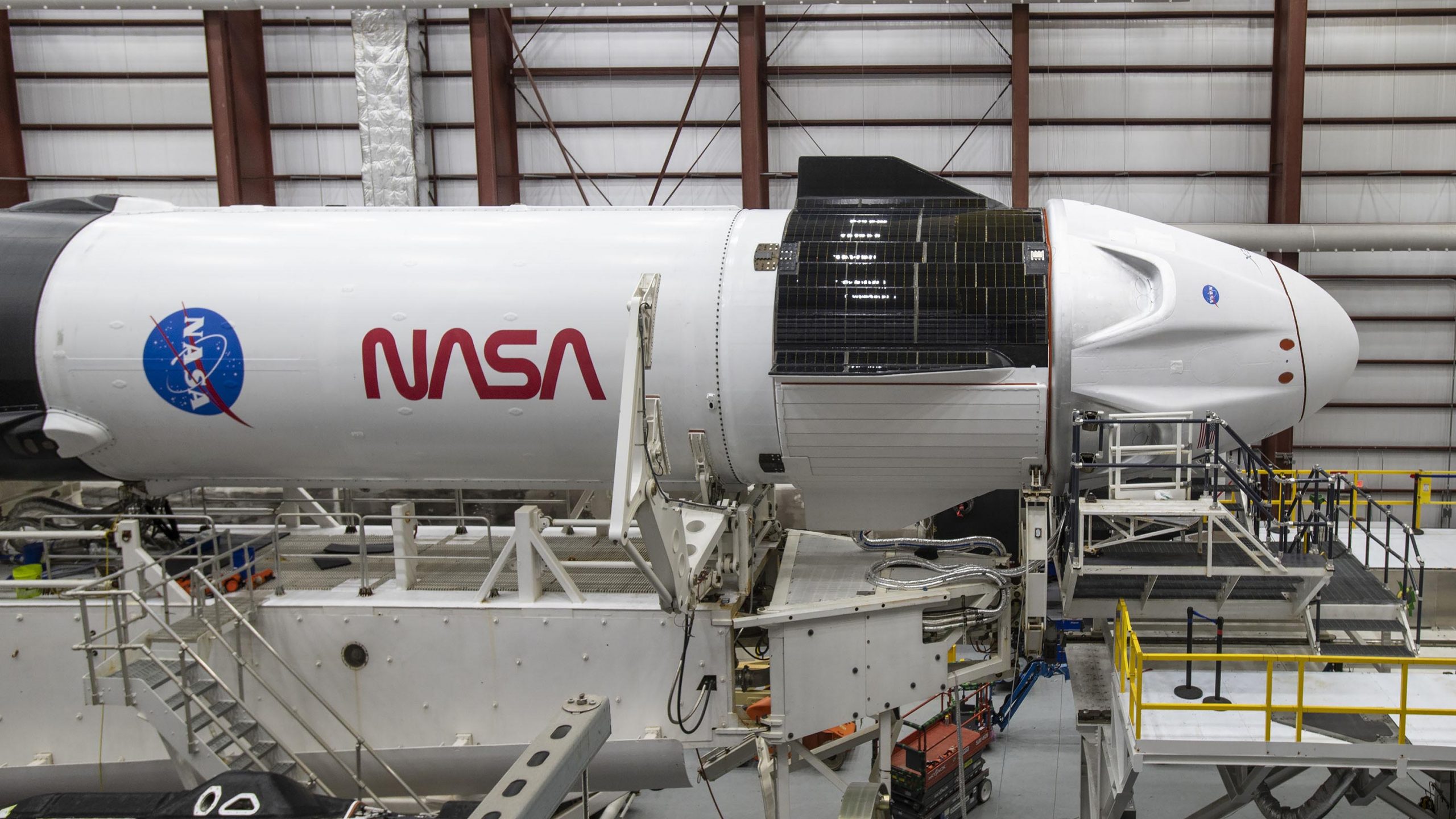

News
SpaceX’s first operational NASA astronaut mission (almost) ready for launch
SpaceX and NASA have completed the last major review standing between Crew Dragon and Falcon 9 and the duo’s operational astronaut launch debut, meaning that a routine static fire test is all that really remains.
On Thursday, November 5, the SpaceX Crew Dragon capsule – named “Resilience” – of the first operational SpaceX mission to and from the International Space Station (ISS) as a part of NASA’s Commercial Crew Program (CCP) arrived at the Launch Complex 39A hangar at the Kennedy Space Center.
SpaceX is one of two commercial partners that NASA works with to develop a reliable system of crew transportation to and from the International Space Station. Since the retirement of NASA’s space shuttle program, the United States has been reliant on Russia and its Soyuz program to fulfill the task of maintaining an American presence aboard the ISS. With SpaceX’s first operational CCP mission – dubbed Crew-1 – a new era of commercialized crewed spaceflight will be ushered in.
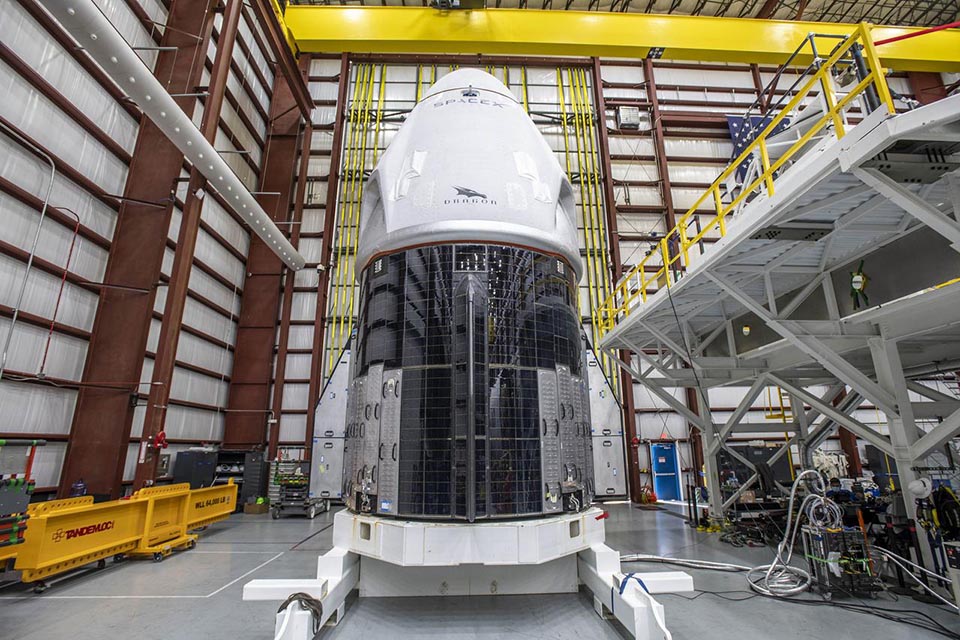
On November 10th, SpaceX and NASA officials convened for a press conference following the successful completion of the Crew-1 flight readiness review (FRR) – the last major review standing between the assembled hardware and liftoff. SpaceX senior director of Human Spaceflight Programs Benji Reed listed off an array of historic milestones crossed as part of the FRR, noting that the review’s completion means that NASA has officially certified SpaceX for operational astronaut launches, making it the first and only private company in the world capable of safely launching humans.
Additionally, Reed revealed that Crew-1 and Cargo Dragon 2’s imminent December 2nd launch debut will together ring in a potentially unprecedented era in commercial spaceflight. Crew-1 – barring surprises in orbit – will further mark the longest continuous American spaceflight ever, beating a record set by a Skylab mission in the early 1970s if Crew Dragon remains in orbit for the full planned 180-210 days.
“Over the next 15 months, we will fly seven Crew and Cargo Dragon missions for NASA. That means that starting with Crew-1, there will be a continuous presence of SpaceX Dragons on orbit. Starting with the cargo mission CRS-21, every time we launch a Dragon, there will be two Dragons in space – simultaneously – for extended periods of time. Truly, we are returning the United States’ capability for full launch services and we are very, very honored to be a part of that.”
Benji Reed, SpaceX – November 10th, 2020
On a more technical level, Reed noted that SpaceX has decided to replace a component of Falcon 9’s upper stage ‘purge system’ and will bring the whole rocket horizontal later today (November 10th). That swap will delay Falcon 9’s Crew-1 static fire from ~8pm today to ~8pm on Wednesday, November 11th. The Crew-1 mission remains on track to launch no earlier than (NET) 7:49 pm EDT, Saturday, November 14th.
The Crew’s All Here
Three days later, after departing Johnson Space Center via a chartered flight from Ellington Field on Sunday, November 8, the four crew members of the Crew-1 mission arrived in Florida by plane at Kennedy Space Center’s former space shuttle landing facility.
Upon arrival, the crew members – NASA astronauts Victor Glover, Mike Hopkins, Shannon Walker, and Soichi Noguchi of the Japanese Aerospace Exploration Agency – were greeted by NASA Administrator Jim Bridenstine, Agency Deputy Administrator Jim Morhard, Kennedy Space Center Director Bob Cabana, and manager of JAXA’s ISS program, Junichi Sakai.
“Today we are taking another big leap in this transformation in how we do human spaceflight. What we’re talking about here is the commercialization of space. NASA is one customer of many customers in a very robust commercial marketplace in low-Earth orbit,” NASA Administrator Jim Bridenstine said.
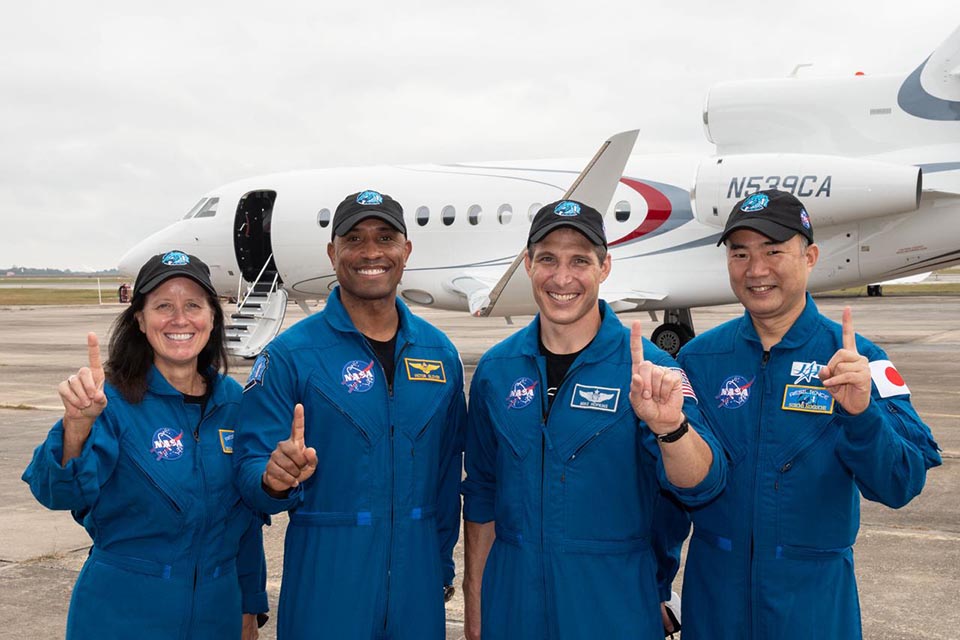
Final Milestones Ahead of Flight
After arriving at their launch site in Florida, the four-member crew made the short journey to the LC-39A horizontal integration facility acquainting themselves with their “Resilience” Dragon capsule and the SpaceX Falcon 9 booster that will soon propel them to space. The Dragon capsule had been oriented horizontally and mated with the Falcon 9 first and second stages.
Initially targeting liftoff on October 31, the Crew-1 mission experienced a delay after the SpaceX GPSIII-SV04 B1062 Falcon 9 vehicle suffered an early start anomaly initiating an autonomous pad abort at T-2 seconds.
As the GPS B1062 and Crew-1 B1061 Falcon 9 vehicles were likely built simultaneously, SpaceX and NASA decided to take time to inspect all engines, as well as those of the upcoming NASA, European Space Agency Michael Freilich Sentinel-6 booster, B1063. After replacing a number of engines, both missions are on track to launch before the end of the month.
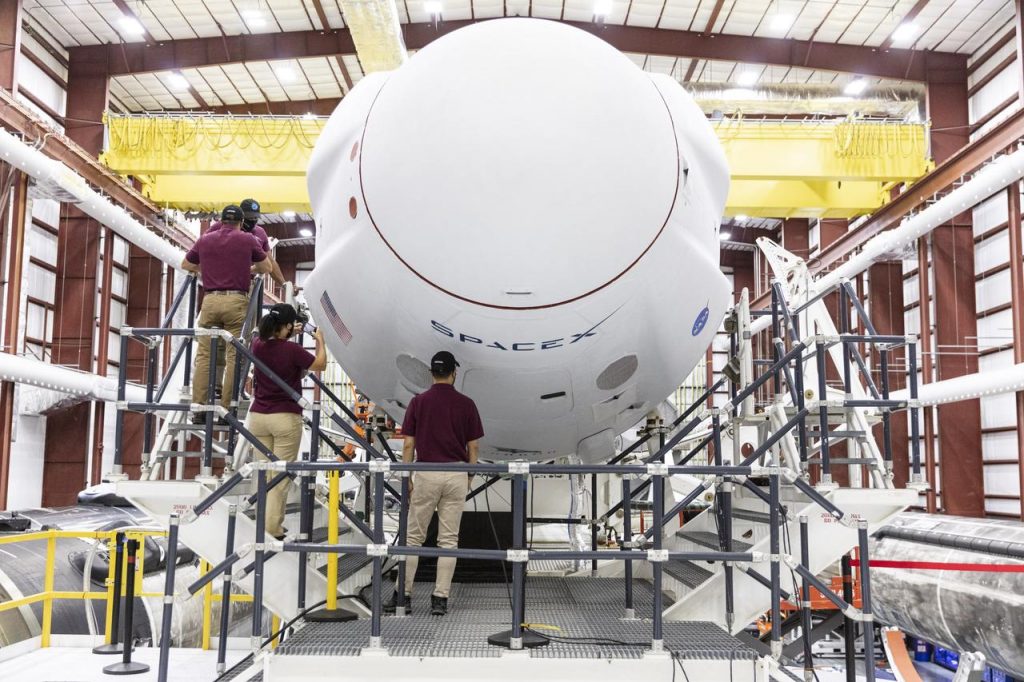
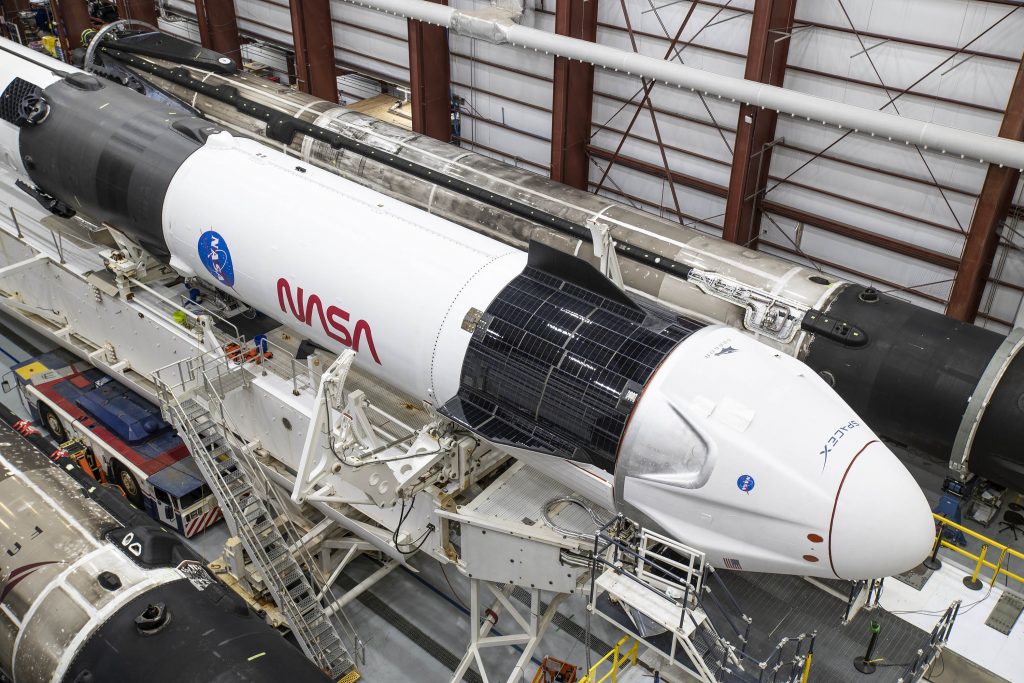
On Monday, November 9, SpaceX and NASA managers began the tedious process of completing a flight readiness review. The meeting that extends an entire day, or two, involves managers from SpaceX, NASA’s Commercial Crew Program, and the International Space Station program collaborating in discussion to conduct a joint pre-flight examination of all previous specialized reviews – such as ones done specifically for the Dragon capsule or the Falcon 9 booster. The meeting also serves as an opportunity for every department to discuss and close out any remaining concerns. The meeting began at 9 am on Monday, November 9, and concluded on Tuesday, November 10.
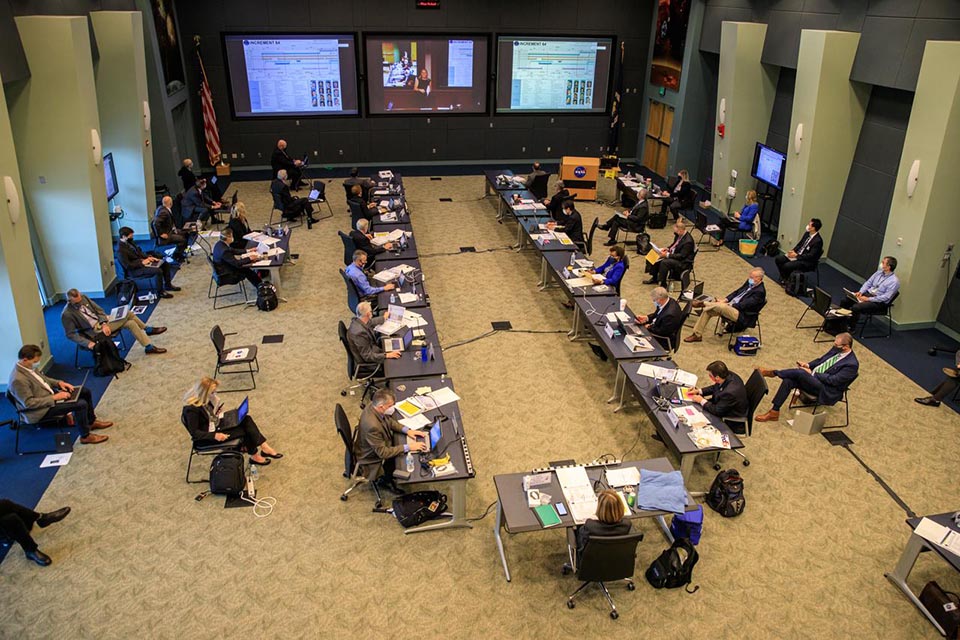
The B1061 Falcon 9 booster and Crew Dragon “Resilience” capsule were transported the short distance from the hangar to the launchpad ahead of the test firing of the nine Merlin 1D engines – a final test to certify all flight-critical hardware ahead of the launch attempt. Clearing the final hurdle before flight, SpaceX officially acknowledged that the Crew-1 mission is targeting liftoff at 7:49pm EST (0049 UTC on Nov. 15) on Saturday, November 14 from LC-39A at the Kennedy Space Center.
Following liftoff, the Dragon capsule “Resilience” will separate from the Falcon 9 first stage and continue to propel its crew on an uphill journey to rendevous with the ISS approximately seven and a half hours later.
Live hosted NASA and SpaceX coverage of the events will begin approximately three and half hours prior to liftoff at 3:30 pm EST and will be available on NASA TV and the SpaceX website.
Check out Teslarati’s newsletters for prompt updates, on-the-ground perspectives, and unique glimpses of SpaceX’s rocket launch and recovery processes.
Elon Musk
Tesla investors will be shocked by Jim Cramer’s latest assessment
Jim Cramer is now speaking positively about Tesla, especially in terms of its Robotaxi performance and its perception as a company.

Tesla investors will be shocked by analyst Jim Cramer’s latest assessment of the company.
When it comes to Tesla analysts, many of them are consistent. The bulls usually stay the bulls, and the bears usually stay the bears. The notable analysts on each side are Dan Ives and Adam Jonas for the bulls, and Gordon Johnson for the bears.
Jim Cramer is one analyst who does not necessarily fit this mold. Cramer, who hosts CNBC’s Mad Money, has switched his opinion on Tesla stock (NASDAQ: TSLA) many times.
He has been bullish, like he was when he said the stock was a “sleeping giant” two years ago, and he has been bearish, like he was when he said there was “nothing magnificent” about the company just a few months ago.
Now, he is back to being a bull.
Cramer’s comments were related to two key points: how NVIDIA CEO Jensen Huang describes Tesla after working closely with the Company through their transactions, and how it is not a car company, as well as the recent launch of the Robotaxi fleet.
Jensen Huang’s Tesla Narrative
Cramer says that the narrative on quarterly and annual deliveries is overblown, and those who continue to worry about Tesla’s performance on that metric are misled.
“It’s not a car company,” he said.
He went on to say that people like Huang speak highly of Tesla, and that should be enough to deter any true skepticism:
“I believe what Musk says cause Musk is working with Jensen and Jensen’s telling me what’s happening on the other side is pretty amazing.”
Tesla self-driving development gets huge compliment from NVIDIA CEO
Robotaxi Launch
Many media outlets are being extremely negative regarding the early rollout of Tesla’s Robotaxi platform in Austin, Texas.
There have been a handful of small issues, but nothing significant. Cramer says that humans make mistakes in vehicles too, yet, when Tesla’s test phase of the Robotaxi does it, it’s front page news and needs to be magnified.
He said:
“Look, I mean, drivers make mistakes all the time. Why should we hold Tesla to a standard where there can be no mistakes?”
It’s refreshing to hear Cramer speak logically about the Robotaxi fleet, as Tesla has taken every measure to ensure there are no mishaps. There are safety monitors in the passenger seat, and the area of travel is limited, confined to a small number of people.
Tesla is still improving and hopes to remove teleoperators and safety monitors slowly, as CEO Elon Musk said more freedom could be granted within one or two months.
News
Tesla launches ultra-fast V4 Superchargers in China for the first time
Tesla has V4 Superchargers rolling out in China for the first time.

Tesla already has nearly 12,000 Supercharger piles across mainland China. However, the company just initiated the rollout of the ultra-fast V4 Superchargers in China for the first time, bringing its quick-charging piles to the country for the first time since their launch last year.
The first batch of V4 Superchargers is now officially up and running in China, the company announced in a post on Chinese social media outlet Weibo today.
The company said in the post:
“The first batch of Tesla V4 Superchargers are online. Covering more service areas, high-speed charging is more convenient, and six-layer powerful protection such as rain and waterproof makes charging very safe. Simultaneously open to non-Tesla vehicles, and other brands of vehicles can also be charged. There are more than 70,000 Tesla Superchargers worldwide. The charging network layout covers 100% of the provincial capitals and municipalities in mainland China. More V4 Superchargers will be put into use across the country. Optimize the charging experience and improve energy replenishment efficiency. Tesla will accompany you to the mountains, rivers, lakes, and seas with pure electricity!”
The first V4 Superchargers Tesla installed in China are available in four cities across the country: Shanghai, Zhejiang, Gansu, and Chongqing.

Credit: Tesla China
Tesla has over 70,000 Superchargers worldwide. It is the most expansive and robust EV charging network in the world. It’s the main reason why so many companies have chosen to adopt Tesla’s charging connector in North America and Europe.
In China, some EVs can use Tesla Superchargers as well.
The V4 Supercharger is capable of charging vehicles at speeds of up to 325kW for vehicles in North America. This equates to over 1,000 miles per hour of charging.
Elon Musk
Elon Musk hints at when Tesla could reduce Safety Monitors from Robotaxi
Tesla could be reducing Safety Monitors from Robotaxi within ‘a month or two,’ CEO Elon Musk says.

Elon Musk hinted at when Tesla could begin reducing Safety Monitors from its Robotaxis. Safety Monitors are Tesla employees who sit in the front passenger seat during the driverless rides, and are there to ensure safety for occupants during the earliest rides.
Tesla launched its Robotaxi fleet in Austin last Sunday, and after eight days, videos and reviews from those who have ridden in the driverless vehicles have shown that the suite is safe, accurate, and well coordinated. However, there have been a few hiccups, but nothing that has put anyone’s safety in danger.
A vast majority — close to all of the rides — at least according to those who have ridden in the Robotaxi, have been performed without any real need for human intervention. We reported on what was the first intervention last week, as a Safety Monitor had to step in and stop the vehicle in a strange interaction with a UPS truck.
Watch the first true Tesla Robotaxi intervention by safety monitor
The Tesla and UPS delivery truck were going for the same street parking space, and the Tesla began to turn into it. The UPS driver parallel parked into the spot, which was much smaller than his truck. It seemed to be more of an instance of human error instead of the Robotaxi making the wrong move. This is something that the driverless cars will have to deal with because humans are aggressive and sometimes make moves they should not.
The Safety Monitors have not been too active in the vehicles. After all, we’ve only seen that single instance of an intervention. There was also an issue with the sun, when the Tesla braked abnormally due to the glare, but this was an instance where the car handled the scenario and proceeded normally.
With the Robotaxi fleet operating impressively, some are wondering when Tesla will begin scaling back both the Safety Monitors and Teleoperators that it is using to ensure safety with these early rides.
CEO Elon Musk answered the inquiry by stating, “As soon as we feel it is safe to do so. Probably within a month or two.”
As soon as we feel it is safe to do so.
Probably within a month or two. We continue to improve the Tesla AI with each mile driven.
— Elon Musk (@elonmusk) June 30, 2025
Musk’s response seems to confirm that there will be fewer Teleoperators and Safety Monitors in the coming months, but there will still be some within the fleet to ensure safety. Eventually, that number will get to zero.
Reaching a point where Tesla’s Robotaxi is driverless will be another significant milestone for the company and its path to fully autonomous ride-sharing.
Eventually, Tesla will roll out these capabilities to consumer-owned vehicles, offering them a path to generate revenue as their car operates autonomously and completes rides.
For now, Tesla is focusing on perfecting the area of Austin where it is currently offering driverless rides for just $4.20 to a small group of people.
-

 News5 days ago
News5 days agoTesla Robotaxi’s biggest challenge seems to be this one thing
-

 News2 weeks ago
News2 weeks agoTesla confirms massive hardware change for autonomy improvement
-

 Elon Musk2 weeks ago
Elon Musk2 weeks agoElon Musk slams Bloomberg’s shocking xAI cash burn claims
-

 News2 weeks ago
News2 weeks agoTesla features used to flunk 16-year-old’s driver license test
-

 News2 weeks ago
News2 weeks agoTesla China roars back with highest vehicle registrations this Q2 so far
-

 News2 weeks ago
News2 weeks agoTexas lawmakers urge Tesla to delay Austin robotaxi launch to September
-

 News2 weeks ago
News2 weeks agoTesla dominates Cars.com’s Made in America Index with clean sweep
-

 News2 weeks ago
News2 weeks agoTesla’s Grok integration will be more realistic with this cool feature





















